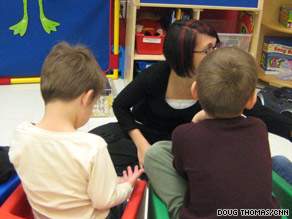|

Statewide Parent Advocacy Network
presents
basic rights in special education
An
introduction to the rights and responsibilities of
parents of children with special needs under
the Individuals with Disabilities Education Act (IDEA) 2004,
the State Special Education Code 2006, and
Section 504 of the Vocational Rehabilitation Act.
Learn to identify your dreams and goals for your children, and the
laws and advocacy strategies that will help your children reach these goals.
October 15, 2009
7:00 - 9:00pm
Franklin School
85 Curtis Street
Bloomfield, NJ
PRESENTER:
GERALDINE MOORE-NEILL
Parents and educators of children who are already receiving special education
services and parents and educators of children who are having difficulty in school but may have not been determined to be
eligible for special education services will benefit from this training. Professional Development hours are provided.
This Workshop is FREE
PLEASE CONTACT
TO REGISTER FOR THIS EVENT!
Study: More cases of autism in U.S. kids than previously realized

Children at the Marcus Autism Center in Atlanta, Georgia, receive instruction
on March 5, 2009.
"This is a significant issue that needs immediate attention," Dr. Ileana Arias, deputy director of the
Centers for Disease Control and Prevention said Friday. "A concerted effort and substantial national response is warranted."
The study used data from the federal government's 2007 national survey of children's health. The survey
of parents was conducted by the Health Resources and Services Administration, and by the Centers for Disease Control and Prevention.
The results are based on a national telephone survey of more than 78,000 parents of children ages 3 to
17.
In the study, parents were asked whether a health care provider had ever told them their child had an
autism spectrum disorder. ASD is a group of brain disorders comprising autism and two less severe disorders: Asperger's disorder and pervasive developmental disorder not otherwise specified.
Children with the disorder show impairment in social interaction and in their ability to communicate.
They often display repetitive behavior.
The investigators also asked a follow-up question: Were the children considered to have ASD now? Nearly
40 percent of the parents and guardians said no.
That finding led the authors to question whether some of the children originally diagnosed as having ASD
may have been improperly diagnosed, since the disorders are not considered curable.
But Kogan said the two surveys cannot be compared because the earlier investigators did not ask the follow-up
question about whether the children were still considered to have the disorder.
Still, based on the findings, lead author Dr. Michael D. Kogan of HRSA's maternal and child health bureau
estimated the prevalence of ASD among U.S. children ages 3 to 17 at 110 per 10,000 -- slightly more than 1 percent.
Boys were four times as likely as girls to have ASD, and non-Hispanic black and multiracial children were
less likely than non-Hispanic white children.
He estimated that 673,000 children have ASD in the United States.
Monday's findings of nearly 1 in 100 appear to indicate an increase from the average of 1 in 150 that
was reported in 2003, the researchers said.
The researchers urged caution in interpreting the change, noting that an increase in diagnoses does not
necessarily mean that more children have the disorder. It could simply reflect a heightened awareness of the disorder.
"We don't know whether the change in the number over time is a result of the change in the actual condition,
in the actual number of conditions or in part due to the fact that the condition is being recognized differently," Arias said.
She said that preliminary results from a separate, CDC-funded study she is working on also indicate that
about 1 percent of children in the United States are affected by ASD. That study is to be published later this year, she said.
"This is a behavioral diagnosis, and it's difficult to make, and it's difficult to make at young ages,"
said Dr. Peter van Dyck, HRSA's associate administrator for maternal and child health.
Half of the cases were considered mild by their parents, the study reported.
The results underscore the importance of creating policies that will result in early identification and
intervention, the officials said.
The reports raise "a lot of questions about how we are preparing in terms of housing, employment, social
support -- all the issues that many of these people are going to need," said Dr. Tom Insel, director of the National Institute
of Mental Health.
"It also raises questions about how well we're prepared in the educational system to provide for the special
needs of many of these kids."
Insel said the federal government is beefing up the resources it is mobilizing to address
autism and related disorders, with $85 million being appropriated by the National Institutes of Health and $48 million for
next year by the HRSA.
GOVERNOR CORZINE SIGNS THE AUTISM INSURANCE REFORM BILL
"Today, August 13, 2009, in a ceremony at Children's Specialized Hospital in New Brunswick, Governor Jon Corzine signed
Autism Insurance Reform Bill S. 1651/A. 2238 into law. This legislation requires insurance companies to provide coverage
of evidence-based, medically necessary autism therapies. The law covers up to $36,000 annually for a child with autism
that is 21 years of age or younger. Coverage includes Applied Behavior Analysis (ABA) therapy, which is recognized as an effective,
evidence-based treatment for children with autism.
“This is a tremendous victory for the New Jersey autism community. The lives of many families will change for the
better because more will have insurance coverage for medically necessary therapies including applied behavior analysis. By
signing this bill into law, Governor Jon Corzine stands firmly with us and the New Jersey legislature, which passed the bills
with overwhelming bipartisan support. We remain indebted to Assembly Speaker Roberts, Assemblyman Prieto, Assemblywoman Voss,
and Senator Vitale for their leadership in ending insurance discrimination against people with autism in the Garden State”
stated long time advocate and parent Christine Bakter, NJ Statewide Advocacy Chair at Autism Speaks.
In addition to our state efforts, the push for federal legislature that would end discrimination against those with
autism is moving forward. New Jersey Congressman Mike20Doyle recently proposed an amendment to the America's Affordable
Health Choices Act of 2009 (HR 3200), which subsequently passed out of the House Energy and Commerce Committee, that addressed
autism insurance discrimination. Congressman Doyle is also a sponsor of the Autism Treatment of Acceleration Act (ATAA)
which includes a federal autism insurance mandate. New Jersey co-sponsors of the ATAA include Representative Christopher
Smith, Representative Steven Rothman and Representative Donald Payne. Senator Robert Menendez and Senator Frank Lautenberg
are co-sponsors of the senate version of the ATAA."
Court Affirms Reimbursement for Special Education
Published: June 22, 2009 - The New York Times
In a decision that could help disabled students obtain needed services and cost school districts millions of dollars, the
Supreme Court ruled on Monday that parents of special-education students may seek government reimbursement for private school tuition,
even if they have never received special-education services in public school.
The case before the court involved a struggling Oregon high school student, identified in court documents only as T. A.,
whose parents removed him from public school in the Forest Grove district in his junior year and enrolled him in a $5,200-a-month
residential school.
Although Forest Grove officials had noticed T. A.’s difficulties and evaluated him for learning disabilities, he
was found ineligible for special-education services. Only after he enrolled in the private school did doctors say T. A. had
attention deficit hyperactivity disorder and other disabilities.
While most of the nation’s six million special-education students attend public school, as T. A. did for many years,
thousands of families with disabled children, convinced that the public schools lack appropriate placements, avoid the public
schools altogether. Instead, they enroll their children in expensive private schools for students with emotional or learning
disabilities, and then seek reimbursement.
Nationally, about 90,000 special-education students are in private schools, most of them referred by their public schools.
In 2007-8, the New York City schools, which filed a friend-of-court brief supporting Forest Grove, paid $89 million in
private-school tuition for disabled students whose parents had placed them there, up from $53 million two years earlier. In
2007-8, the city received 4,368 requests for reimbursement from parents who enrolled their children in private school; of
those, more than half had not received services in public school.
The issue in the Forest Grove case was whether a 1997 amendment to the Individuals with Disabilities Education Act (or
IDEA) prohibited private-school tuition reimbursement for students who never received special-education services in public
school.
The amendment says tuition may be available for students with disabilities “who previously received special-education”
services in public school, if the school did not make a free and appropriate public education (or FAPE) available in a timely
manner.
Forest Grove, backed by school-boards associations across the country, argued that the amendment precluded reimbursement
for those, like T. A., who never received special-education services in public school.
But the high court, in a 6-to-3 ruling, rejected that argument.
“We conclude that IDEA authorizes reimbursement for the cost of private special education services when a school
district fails to provide a FAPE and the private school placement is appropriate, regardless of whether the child previously
received special education or related services through the public school,” Justice John Paul Stevens wrote in the majority opinion.
Justice Stevens said the school district’s interpretation would produce a result “bordering on the irrational.”
“It would be strange for the act to provide a remedy, as all agree it does, where a school district offers a child
inadequate special-education services but to leave parents without relief in the more egregious situation in which the school
district unreasonably denies a child access to such services altogether,” he wrote.
He was joined by Chief Justice John G. Roberts Jr. and Justices Anthony M. Kennedy, Ruth Bader Ginsburg, Stephen G. Breyer and Samuel A. Alito Jr.
In his dissent, Justice David H. Souter, joined by Justices Antonin Scalia and Clarence Thomas, said that the disabilities law was designed to promote cooperation between school districts and families in developing an
individualized education plan for each disabled student. The dissent also discussed the high costs of private-school placements.
“Special education can be immensely expensive, amounting to tens of billions of dollars annually and as much as 20
percent of public schools’ general operating budgets,” Justice Souter wrote. “Given the burden of private
school placement, it makes good sense to require parents to try to devise a satisfactory alternative within the public schools.”
The Supreme Court considered the issue of tuition reimbursement in a New York case two years ago, but split 4 to 4, with
Justice Kennedy not taking part.
www.unitedbyautism.org
BLOOMFIELD SET FOR APPROXIMATELY $2.1 MILLION IN FEDERAL STIMULUS AWARDS! Press here for more details.
BLOOMFIELD SUCCESS PRESS RELEASE - April 10, 2009
ARTICLES OF INTEREST - CARTOONS COULD BE USED TO SPOT AUTISM
|





